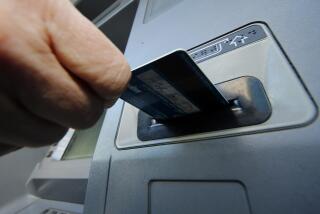The Fight Against Crime: Notes From the Front : Ring of Thieves Targets ATMs for Quick Cash
- Share via
They sit in a nondescript van trying to be as discreet as possible.
The man in the driver’s seat pretends to read a book but is also watching for cops.
The guy in the back has a video camera with a long-distance lens, focused on the bank. For hours, he records the finger movements that reveal the secret personal identification codes people enter to access their ATM accounts.
Later, the men will come back and--if they are lucky--withdraw thousands of dollars in cash from those same accounts.
The crime is bank card fraud, an offense for which those convicted go to federal prison. The risks are many. And police say the odds are good that a criminal will sit in a van all day waiting for a chance to score and still come up empty.
But for more than a year and a half, a ring of ATM thieves--who may well look like the men described above--have been wandering the Valley, and much of the rest of Southern California, in quest of easy money.
“Listen,” Jim Bauer, a spokesman for the U.S. Secret Service, said in a confidential tone. “We don’t want any copy cats. We hate to even talk about it because we don’t want to plant the seed in people’s heads . . . It is not common yet, but people are pretty well worried about it.”
About all Bauer could say was yes, the Secret Service is investigating several ATM theft rings in the area, but because arrests are pending, he was unable to give details for fear of jeopardizing the operation.
Last December, however, the Secret Service estimated that the ring had stolen at least $100,000 from Bank of America customers’ accounts, mostly in the Valley and the Palm Springs area. That was seven months ago.
Since then, officers throughout Southern California have been on the lookout for an apparently roving band of thieves who repeatedly strike, only to quickly disappear.
According to law enforcement personnel, this is how a typical operation might work:
First, thieves stake out a bank machine, often waiting in a van or truck parked so that they can see the ATM’s keyboard. As people use the ATM, the crooks record their personal access numbers. If the thieves are using a video camera, the time of each transaction is automatically recorded. If they are using binoculars or a telescope, they record the time themselves.
Next, if customers throw their receipts away at the ATM, the thieves make a mental note, and later, dig the receipts out of the trash. By pairing the time on the ATM receipt with the time on the video recorder, the thieves are able to match account numbers with personal access codes.
And finally, using an encoding machine hooked up to a personal computer, the bad guys encode the purloined account numbers on whatever suits them--everything from stolen bank cards to pieces of poster board--and withdraw money.
The only limit on the take is the balance in the account and the daily limit on ATM withdrawals--usually $200 to $500.
Perhaps unsurprisingly, Los Angeles, which is already the bank robbery capital of the country, has also won a place in the lore of ATM fraud.
In 1988, the city’s Security Pacific Bank lost nearly $350,000 when a special card was used to steal cash from 300 customer accounts over a long weekend. At the time, it was the largest reported ATM crime.
Four years later, a 28-year-old Los Angeles computer programmer was indicted on charges of organizing a plot in which he allegedly planned to raid 7,400 Bank of America accounts via ATMs.
Through his job at GTE Information Services, which handled electronic fund transfers for financial institutions and ATM networks, Mark Koenig was able to obtain customers’ account numbers, prosecutors said. They said he smuggled an encoding machine out of the office and waited for a three-day weekend when the group--which included his wife--planned to travel around the country making cash withdrawals.
The plot, which could have netted $17 million, was uncovered when one of Koenig’s co-conspirators balked and informed the Secret Service of the plan, authorities said.
Since then, some banks have begun leaving out the final digits of account numbers on ATM receipts. To avoid becoming a victim, authorities suggest that ATM users position their bodies to block an observer’s view of the keypad when entering their codes, and dispose of their torn-up receipts at home.
More to Read
Sign up for Essential California
The most important California stories and recommendations in your inbox every morning.
You may occasionally receive promotional content from the Los Angeles Times.













